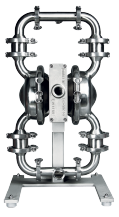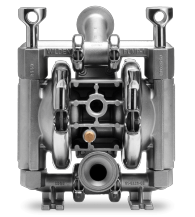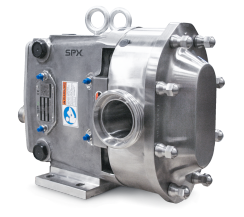Hygienic Pump Design
The food industry is extensively regulated and at AxFlow UK, we ensure to offer the best approved equipment to you and your business. Please find our overview of the different hygienic approval bodies and pump design.
There are numerous regulations that apply to pumps in food, beverage, and pharmaceutical processing, namely; EHEDG, 3A, BfR, FDA, USP Class VI, and EC 1935/2004. However, which ones apply to a particular process or food product and, as some can increase the cost of the pump quite considerably, consideration has to be as to which is the most appropriate. Peter Carfrae and Malcolm Walker of AxFlow take a look at the various hygiene standards and their implication for pumps and their users.
Although there is still no legal obligation on food manufacturers to use hygienically certified fluid handling equipment, the ever increasing costs both financially and potential harm to a brand's reputation resulting from hygienically defective products has meant that never before has there been so much pressure on food manufacturers to utilise the correct hygienic process equipment in the sight of the law.

There are two basic groups of approval, those that apply to material compatibility and those to the actual design of the pump. Taking those concerning material compatibility, there several globally recognised approval bodies the oldest being the US Food and Drug Administration (FDA) and which is still seen worldwide as the basic benchmark for material compatibility.

However, the new kid on block in the guise of EC 1935/2004 has by and large superseded FDA. The reason for this being that EC 1935/2004 has wider and stricter criteria. For instance, it requires that compounds must be examined to more specific tests than FDA and requires traceability, whereas FDA does not necessarily do this. The implication of this is that not all FDA materials will meet EC1935/2004 requirements.

A third lesser known approval that should be mentioned in connection with FDA and EC 1935/2004 is the German (BfR) system which is widely used for some rubber compounds in the EU because there are gaps in both FDA and EC 1935/2004 when it comes to such compounds.

Lastly, there is USP Class VI which some cite in respect to food and beverage production. The US Pharmacopeia (USP) and the National Formulary (USP NF) USP Class IV approvals are concerned with toxicity from direct contact with a material and a material'sUSP resistance to biological activity with respect to the pharmaceutical and medical industries. Although it could be argued that there is some relevance to food and beverage production, USP approval is not actually applicable as direct contact from a pump's component should not occur, unless something quite catastrophic has happened. Furthermore, cleaning along with pump design are considered the methods by which bacterial growth is avoided in the food industry.
This brings us neatly onto the fact that food compatible materials in themselves are not sufficient in the majority of food production applications to make a pump hygienically acceptable, as its design and cleaning regime must be taken into account.
Hygienic PUMP design
Although you don't need to use hygienically designed pumps, they need to be clean and the amount of time spent cleaning a pumps depends to a large extent on their design. Hygienic design aims to reduce the possibility for the build-up of bacteria by minimising crevices and dead areas, the ease with which the pump can be disassembled for manual cleaning and the nature of material surfaces. This means that it may be less expensive to use a higher priced hygienically certified pump design when you factor in labour costs for maintenance.
Hygienic requirements are typically addressed at the design and development stages of a pump's components as this will remove the need to make modifications or upgrade later in the development cycle, or after equipment has entered service. For pump and manufacturers it is essential to have the design tested against given requirements. The hygienic design of equipment is subsequently assessed and the cleanability of the equipment can be tested.


There are three main design standards that apply to hygienic design: The CE mark ie The Machinery Directive 2006/42/EC, A-3 and EHEDG. The Machinery Directive sets out very clearly the design considerations that need to be taken into account for a hygienically clean pump, but ultimately the manufacturer self certifies the pump so even if the they meet the additional hygiene requirements formulated in the European Standard EN1672-2 there is no absolute guarantee that the pump is biologically safe. Therefore, manufacturers can supplement the CE mark with certification from A-3 and EHEDG. The significant difference is that both these certification bodies go into much more detail having different requirements for different applications, and actually test the product with respect to cleanability rather than just relying on a risk assessment.
The American A-3 organisation has existed since the 1920's and originally concentrated on on the dairy and egg processing industries. Since then it has widened its scope to cover other applications. EHEDG is essentially the European version of A-3 in the same way that EC 1935/2004 is the European version of FDA. Likewise it's generally considered more comprehensive than A-3. However, both organisations have made considerable efforts over the last few years to harmonise their standards.
Selecting the most appropriate pump for an application has to be a two-way decision made by the end user and the pump supplier. The pump supplier has to recognise that the end user will know exactly what hygiene standards have to be met in respect of their products and defer to their greater knowledge. Similarly, the end user must recognise that the pump supplier will be expert in fluid handling technology and must be able to offer a pump that fully complies with relevant standard(s) and cleaning regimes.
The breadth of pump types that are available for food and drink processing applications is considerable and many of these technologies compete with each other. Thus, it makes good sense to review the different technologies either by talking directly with appropriate manufacturers or with a distributor that has a range of appropriate technologies within its portfolio and can provide unbiased advice.










